Chemistry Lab Report: Analysis of Antacids and Titration Techniques
VerifiedAdded on 2022/09/15
|7
|1670
|27
Report
AI Summary
This chemistry lab report analyzes antacids by exploring their chemical properties and effectiveness in neutralizing acids. The report begins with an introduction to antacids, explaining their role in counteracting stomach acid and the principles of acid-base reactions. It then details the experimental procedure, which involves back titration to determine the amount of acid neutralized by the antacids. The report discusses the concepts of acid strength, concentration, and molarity, and how these relate to the titration process. The discussion section explores the importance of stomach acid, the role of antacids in maintaining pH balance, and the potential side effects of antacids. The conclusion summarizes the findings, emphasizing the effectiveness of antacids in neutralizing stomach acid. The report references several scientific studies to support the analysis and findings. The core of the report lies in the application of volumetric analysis and titration techniques to quantify the acid-neutralizing capacity of different antacid formulations.

Analysis of antacids1
ANALYSIS OF ANTACIDS
Name:
School:
Department:
Date:
ANALYSIS OF ANTACIDS
Name:
School:
Department:
Date:
Paraphrase This Document
Need a fresh take? Get an instant paraphrase of this document with our AI Paraphraser
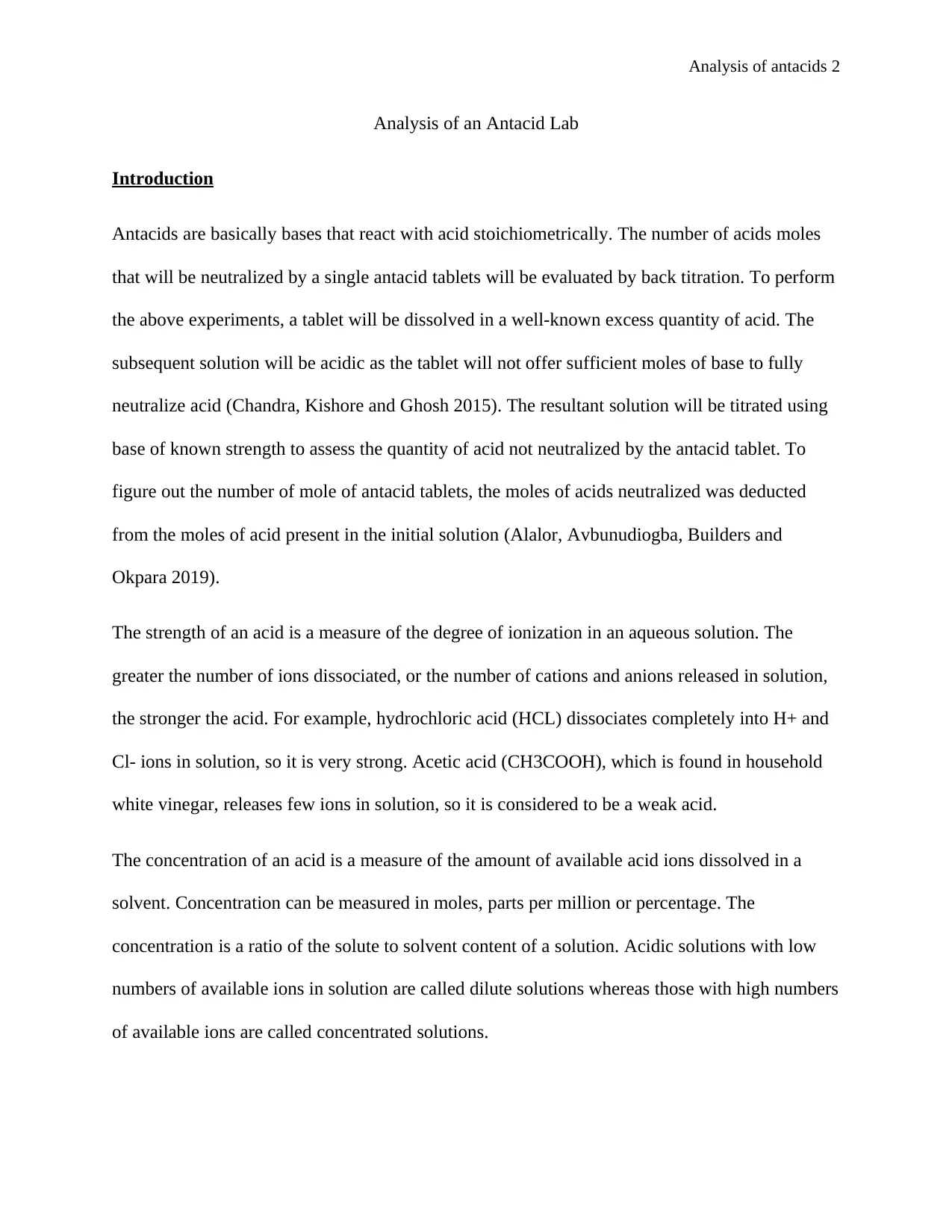
Analysis of antacids 2
Analysis of an Antacid Lab
Introduction
Antacids are basically bases that react with acid stoichiometrically. The number of acids moles
that will be neutralized by a single antacid tablets will be evaluated by back titration. To perform
the above experiments, a tablet will be dissolved in a well-known excess quantity of acid. The
subsequent solution will be acidic as the tablet will not offer sufficient moles of base to fully
neutralize acid (Chandra, Kishore and Ghosh 2015). The resultant solution will be titrated using
base of known strength to assess the quantity of acid not neutralized by the antacid tablet. To
figure out the number of mole of antacid tablets, the moles of acids neutralized was deducted
from the moles of acid present in the initial solution (Alalor, Avbunudiogba, Builders and
Okpara 2019).
The strength of an acid is a measure of the degree of ionization in an aqueous solution. The
greater the number of ions dissociated, or the number of cations and anions released in solution,
the stronger the acid. For example, hydrochloric acid (HCL) dissociates completely into H+ and
Cl- ions in solution, so it is very strong. Acetic acid (CH3COOH), which is found in household
white vinegar, releases few ions in solution, so it is considered to be a weak acid.
The concentration of an acid is a measure of the amount of available acid ions dissolved in a
solvent. Concentration can be measured in moles, parts per million or percentage. The
concentration is a ratio of the solute to solvent content of a solution. Acidic solutions with low
numbers of available ions in solution are called dilute solutions whereas those with high numbers
of available ions are called concentrated solutions.
Analysis of an Antacid Lab
Introduction
Antacids are basically bases that react with acid stoichiometrically. The number of acids moles
that will be neutralized by a single antacid tablets will be evaluated by back titration. To perform
the above experiments, a tablet will be dissolved in a well-known excess quantity of acid. The
subsequent solution will be acidic as the tablet will not offer sufficient moles of base to fully
neutralize acid (Chandra, Kishore and Ghosh 2015). The resultant solution will be titrated using
base of known strength to assess the quantity of acid not neutralized by the antacid tablet. To
figure out the number of mole of antacid tablets, the moles of acids neutralized was deducted
from the moles of acid present in the initial solution (Alalor, Avbunudiogba, Builders and
Okpara 2019).
The strength of an acid is a measure of the degree of ionization in an aqueous solution. The
greater the number of ions dissociated, or the number of cations and anions released in solution,
the stronger the acid. For example, hydrochloric acid (HCL) dissociates completely into H+ and
Cl- ions in solution, so it is very strong. Acetic acid (CH3COOH), which is found in household
white vinegar, releases few ions in solution, so it is considered to be a weak acid.
The concentration of an acid is a measure of the amount of available acid ions dissolved in a
solvent. Concentration can be measured in moles, parts per million or percentage. The
concentration is a ratio of the solute to solvent content of a solution. Acidic solutions with low
numbers of available ions in solution are called dilute solutions whereas those with high numbers
of available ions are called concentrated solutions.
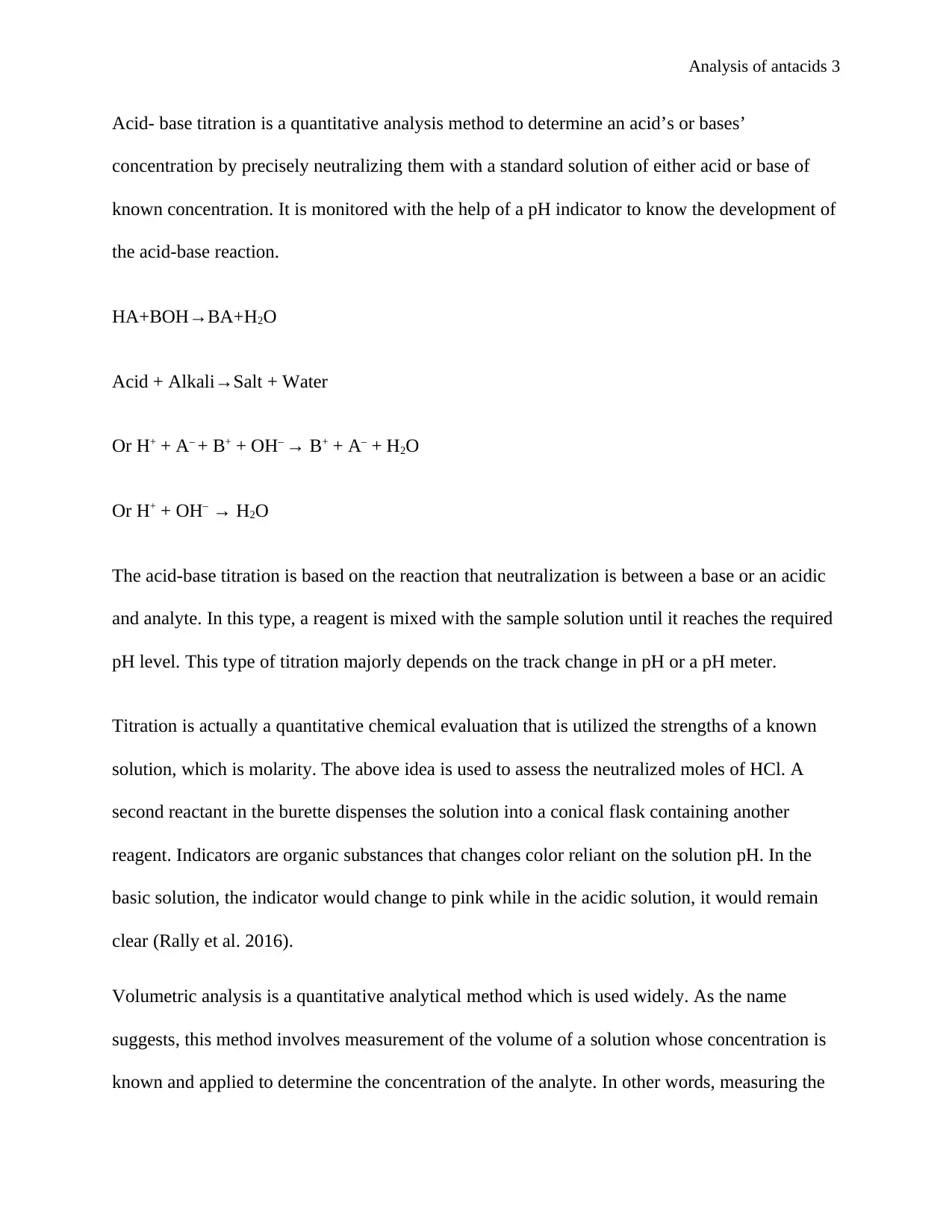
Analysis of antacids 3
Acid- base titration is a quantitative analysis method to determine an acid’s or bases’
concentration by precisely neutralizing them with a standard solution of either acid or base of
known concentration. It is monitored with the help of a pH indicator to know the development of
the acid-base reaction.
HA+BOH→BA+H2O
Acid + Alkali→Salt + Water
Or H+ + A– + B+ + OH– → B+ + A– + H2O
Or H+ + OH– → H2O
The acid-base titration is based on the reaction that neutralization is between a base or an acidic
and analyte. In this type, a reagent is mixed with the sample solution until it reaches the required
pH level. This type of titration majorly depends on the track change in pH or a pH meter.
Titration is actually a quantitative chemical evaluation that is utilized the strengths of a known
solution, which is molarity. The above idea is used to assess the neutralized moles of HCl. A
second reactant in the burette dispenses the solution into a conical flask containing another
reagent. Indicators are organic substances that changes color reliant on the solution pH. In the
basic solution, the indicator would change to pink while in the acidic solution, it would remain
clear (Rally et al. 2016).
Volumetric analysis is a quantitative analytical method which is used widely. As the name
suggests, this method involves measurement of the volume of a solution whose concentration is
known and applied to determine the concentration of the analyte. In other words, measuring the
Acid- base titration is a quantitative analysis method to determine an acid’s or bases’
concentration by precisely neutralizing them with a standard solution of either acid or base of
known concentration. It is monitored with the help of a pH indicator to know the development of
the acid-base reaction.
HA+BOH→BA+H2O
Acid + Alkali→Salt + Water
Or H+ + A– + B+ + OH– → B+ + A– + H2O
Or H+ + OH– → H2O
The acid-base titration is based on the reaction that neutralization is between a base or an acidic
and analyte. In this type, a reagent is mixed with the sample solution until it reaches the required
pH level. This type of titration majorly depends on the track change in pH or a pH meter.
Titration is actually a quantitative chemical evaluation that is utilized the strengths of a known
solution, which is molarity. The above idea is used to assess the neutralized moles of HCl. A
second reactant in the burette dispenses the solution into a conical flask containing another
reagent. Indicators are organic substances that changes color reliant on the solution pH. In the
basic solution, the indicator would change to pink while in the acidic solution, it would remain
clear (Rally et al. 2016).
Volumetric analysis is a quantitative analytical method which is used widely. As the name
suggests, this method involves measurement of the volume of a solution whose concentration is
known and applied to determine the concentration of the analyte. In other words, measuring the
⊘ This is a preview!⊘
Do you want full access?
Subscribe today to unlock all pages.

Trusted by 1+ million students worldwide

Analysis of antacids 4
volume of a second substance that combines with the first in known proportions is known as
Volumetric analysis or titration. It is this method of quantitative analysis that allows us to
determine the concentration of the analyte (Rally et al. 2016).
Basic principles of volumetric analysis: The solution to be analyzed contains an unknown
amount of chemicals. The reagent of unknown concentration reacts with a chemical of an
unknown amount in the presence of an indicator (mostly phenolphthalein) to show the end-point.
It’s the point indicating the completion of the reaction. The volumes are measured by titration
which completes the reaction between the solution and reagent. The volume and concentration of
reagent which are used in the titration show the amount of reagent and solution. The amount of
unknown chemical in the specific volume of solution is determined by the mole fraction of the
equation (McPherson 2014).
Molarity can be termed as number of moles of solution in one liter of solution (m/L) and is the
unit of measurement utilized for the solution strength (M). The initial HCl moles were computed
by utilizing the HCl solution molarity and then multiplying it by the quantity of HCl dispersed
into the tablet. Similarly, the excess number of HCl moles was computed by using the NaOH
solution Molarity and then multiplying it by the total quantity of the NaOH dispensed into the
antacid solution (McPherson 2014).
After assessing the excess and initial HCl moles, the neutralized HCl moles were evaluated
utilizing: [initial moles HCl-excess moles HCl=neutralized moles of HCl]. The moles of HCl
neutralized were divided by the weight of antacid tablets that was weighted to determine the
overall number of moles per gram of the antacid tablet. It is worth noting that the limiting
reactant of this trial was the tablet and excess reagent was the solution of HCl (Flaschka 2013).
volume of a second substance that combines with the first in known proportions is known as
Volumetric analysis or titration. It is this method of quantitative analysis that allows us to
determine the concentration of the analyte (Rally et al. 2016).
Basic principles of volumetric analysis: The solution to be analyzed contains an unknown
amount of chemicals. The reagent of unknown concentration reacts with a chemical of an
unknown amount in the presence of an indicator (mostly phenolphthalein) to show the end-point.
It’s the point indicating the completion of the reaction. The volumes are measured by titration
which completes the reaction between the solution and reagent. The volume and concentration of
reagent which are used in the titration show the amount of reagent and solution. The amount of
unknown chemical in the specific volume of solution is determined by the mole fraction of the
equation (McPherson 2014).
Molarity can be termed as number of moles of solution in one liter of solution (m/L) and is the
unit of measurement utilized for the solution strength (M). The initial HCl moles were computed
by utilizing the HCl solution molarity and then multiplying it by the quantity of HCl dispersed
into the tablet. Similarly, the excess number of HCl moles was computed by using the NaOH
solution Molarity and then multiplying it by the total quantity of the NaOH dispensed into the
antacid solution (McPherson 2014).
After assessing the excess and initial HCl moles, the neutralized HCl moles were evaluated
utilizing: [initial moles HCl-excess moles HCl=neutralized moles of HCl]. The moles of HCl
neutralized were divided by the weight of antacid tablets that was weighted to determine the
overall number of moles per gram of the antacid tablet. It is worth noting that the limiting
reactant of this trial was the tablet and excess reagent was the solution of HCl (Flaschka 2013).
Paraphrase This Document
Need a fresh take? Get an instant paraphrase of this document with our AI Paraphraser
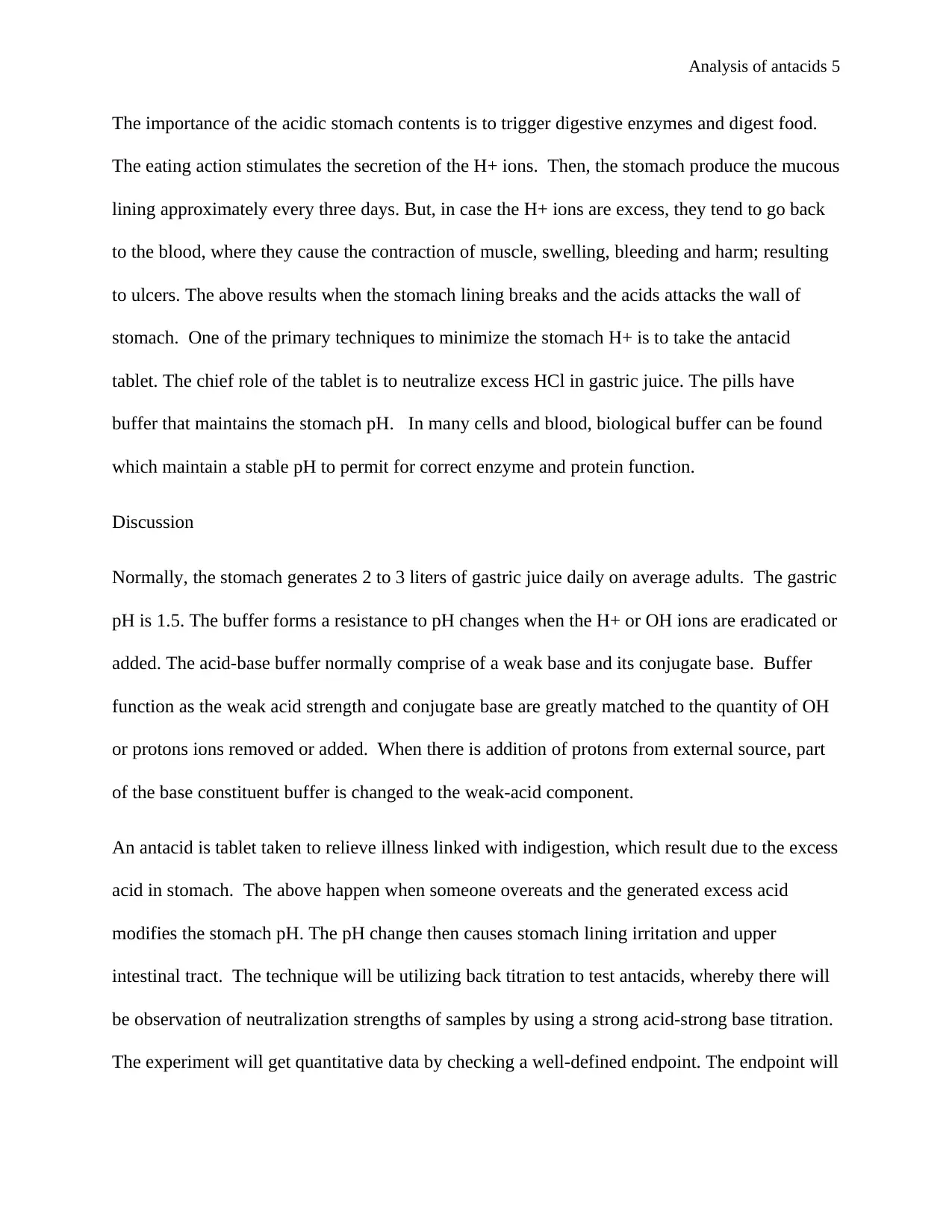
Analysis of antacids 5
The importance of the acidic stomach contents is to trigger digestive enzymes and digest food.
The eating action stimulates the secretion of the H+ ions. Then, the stomach produce the mucous
lining approximately every three days. But, in case the H+ ions are excess, they tend to go back
to the blood, where they cause the contraction of muscle, swelling, bleeding and harm; resulting
to ulcers. The above results when the stomach lining breaks and the acids attacks the wall of
stomach. One of the primary techniques to minimize the stomach H+ is to take the antacid
tablet. The chief role of the tablet is to neutralize excess HCl in gastric juice. The pills have
buffer that maintains the stomach pH. In many cells and blood, biological buffer can be found
which maintain a stable pH to permit for correct enzyme and protein function.
Discussion
Normally, the stomach generates 2 to 3 liters of gastric juice daily on average adults. The gastric
pH is 1.5. The buffer forms a resistance to pH changes when the H+ or OH ions are eradicated or
added. The acid-base buffer normally comprise of a weak base and its conjugate base. Buffer
function as the weak acid strength and conjugate base are greatly matched to the quantity of OH
or protons ions removed or added. When there is addition of protons from external source, part
of the base constituent buffer is changed to the weak-acid component.
An antacid is tablet taken to relieve illness linked with indigestion, which result due to the excess
acid in stomach. The above happen when someone overeats and the generated excess acid
modifies the stomach pH. The pH change then causes stomach lining irritation and upper
intestinal tract. The technique will be utilizing back titration to test antacids, whereby there will
be observation of neutralization strengths of samples by using a strong acid-strong base titration.
The experiment will get quantitative data by checking a well-defined endpoint. The endpoint will
The importance of the acidic stomach contents is to trigger digestive enzymes and digest food.
The eating action stimulates the secretion of the H+ ions. Then, the stomach produce the mucous
lining approximately every three days. But, in case the H+ ions are excess, they tend to go back
to the blood, where they cause the contraction of muscle, swelling, bleeding and harm; resulting
to ulcers. The above results when the stomach lining breaks and the acids attacks the wall of
stomach. One of the primary techniques to minimize the stomach H+ is to take the antacid
tablet. The chief role of the tablet is to neutralize excess HCl in gastric juice. The pills have
buffer that maintains the stomach pH. In many cells and blood, biological buffer can be found
which maintain a stable pH to permit for correct enzyme and protein function.
Discussion
Normally, the stomach generates 2 to 3 liters of gastric juice daily on average adults. The gastric
pH is 1.5. The buffer forms a resistance to pH changes when the H+ or OH ions are eradicated or
added. The acid-base buffer normally comprise of a weak base and its conjugate base. Buffer
function as the weak acid strength and conjugate base are greatly matched to the quantity of OH
or protons ions removed or added. When there is addition of protons from external source, part
of the base constituent buffer is changed to the weak-acid component.
An antacid is tablet taken to relieve illness linked with indigestion, which result due to the excess
acid in stomach. The above happen when someone overeats and the generated excess acid
modifies the stomach pH. The pH change then causes stomach lining irritation and upper
intestinal tract. The technique will be utilizing back titration to test antacids, whereby there will
be observation of neutralization strengths of samples by using a strong acid-strong base titration.
The experiment will get quantitative data by checking a well-defined endpoint. The endpoint will
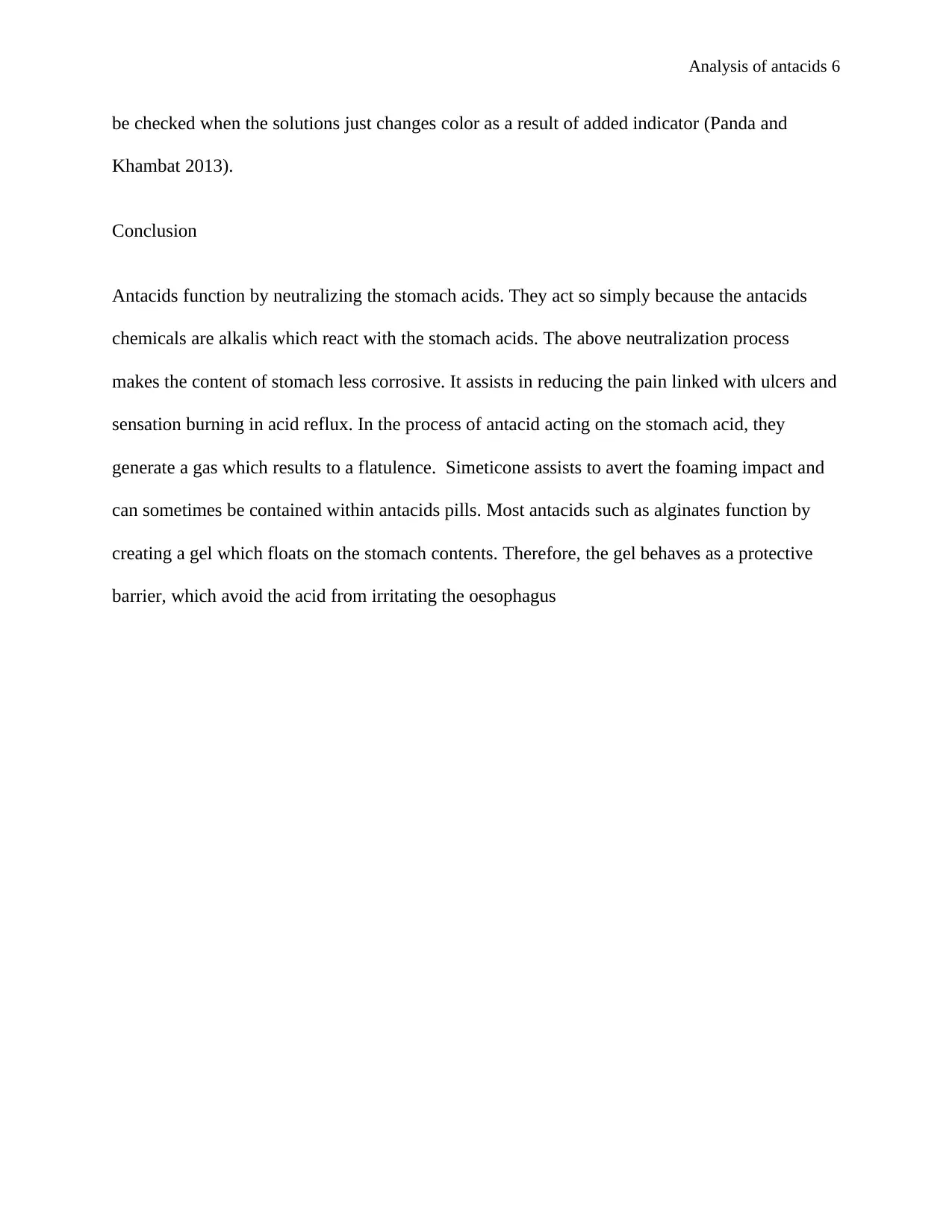
Analysis of antacids 6
be checked when the solutions just changes color as a result of added indicator (Panda and
Khambat 2013).
Conclusion
Antacids function by neutralizing the stomach acids. They act so simply because the antacids
chemicals are alkalis which react with the stomach acids. The above neutralization process
makes the content of stomach less corrosive. It assists in reducing the pain linked with ulcers and
sensation burning in acid reflux. In the process of antacid acting on the stomach acid, they
generate a gas which results to a flatulence. Simeticone assists to avert the foaming impact and
can sometimes be contained within antacids pills. Most antacids such as alginates function by
creating a gel which floats on the stomach contents. Therefore, the gel behaves as a protective
barrier, which avoid the acid from irritating the oesophagus
be checked when the solutions just changes color as a result of added indicator (Panda and
Khambat 2013).
Conclusion
Antacids function by neutralizing the stomach acids. They act so simply because the antacids
chemicals are alkalis which react with the stomach acids. The above neutralization process
makes the content of stomach less corrosive. It assists in reducing the pain linked with ulcers and
sensation burning in acid reflux. In the process of antacid acting on the stomach acid, they
generate a gas which results to a flatulence. Simeticone assists to avert the foaming impact and
can sometimes be contained within antacids pills. Most antacids such as alginates function by
creating a gel which floats on the stomach contents. Therefore, the gel behaves as a protective
barrier, which avoid the acid from irritating the oesophagus
⊘ This is a preview!⊘
Do you want full access?
Subscribe today to unlock all pages.

Trusted by 1+ million students worldwide
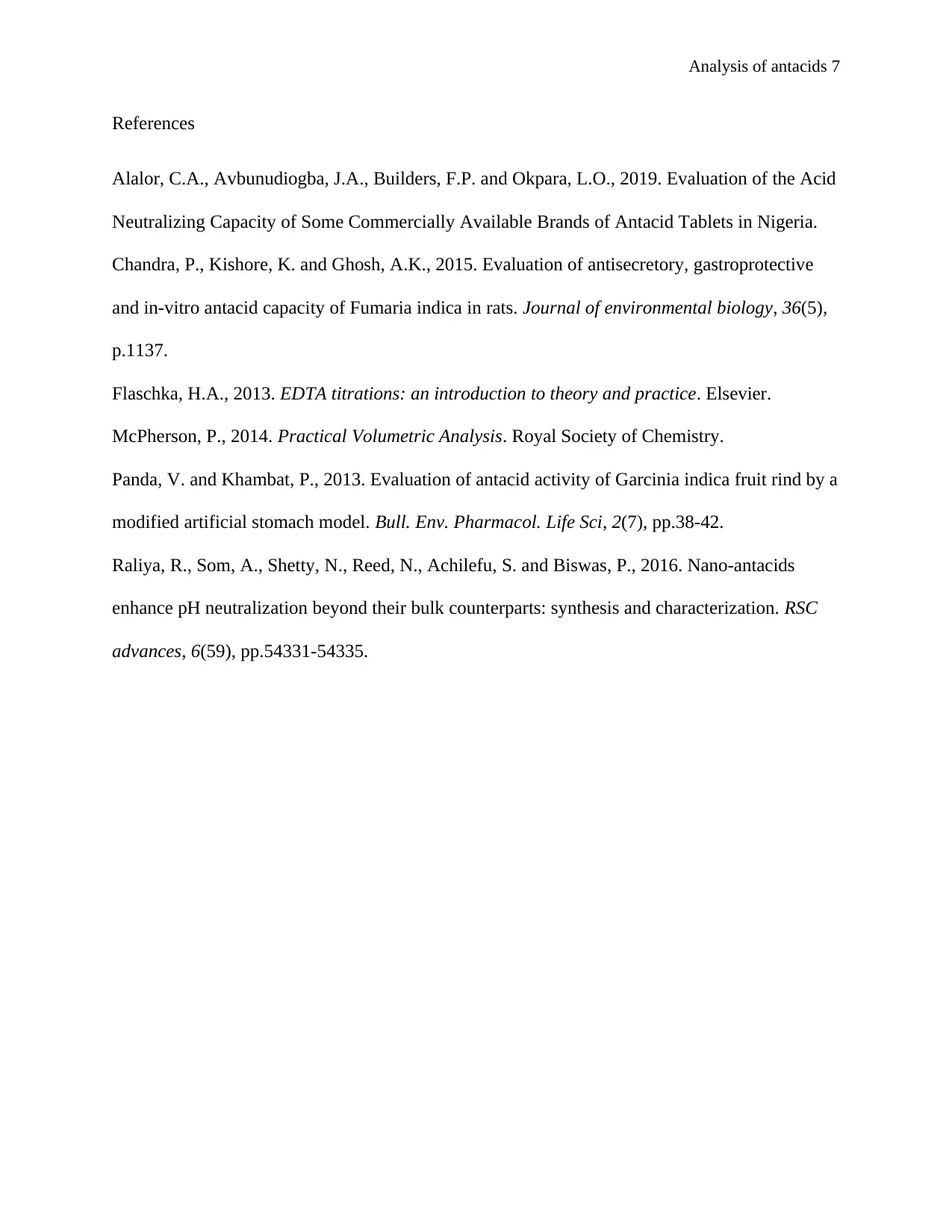
Analysis of antacids 7
References
Alalor, C.A., Avbunudiogba, J.A., Builders, F.P. and Okpara, L.O., 2019. Evaluation of the Acid
Neutralizing Capacity of Some Commercially Available Brands of Antacid Tablets in Nigeria.
Chandra, P., Kishore, K. and Ghosh, A.K., 2015. Evaluation of antisecretory, gastroprotective
and in-vitro antacid capacity of Fumaria indica in rats. Journal of environmental biology, 36(5),
p.1137.
Flaschka, H.A., 2013. EDTA titrations: an introduction to theory and practice. Elsevier.
McPherson, P., 2014. Practical Volumetric Analysis. Royal Society of Chemistry.
Panda, V. and Khambat, P., 2013. Evaluation of antacid activity of Garcinia indica fruit rind by a
modified artificial stomach model. Bull. Env. Pharmacol. Life Sci, 2(7), pp.38-42.
Raliya, R., Som, A., Shetty, N., Reed, N., Achilefu, S. and Biswas, P., 2016. Nano-antacids
enhance pH neutralization beyond their bulk counterparts: synthesis and characterization. RSC
advances, 6(59), pp.54331-54335.
References
Alalor, C.A., Avbunudiogba, J.A., Builders, F.P. and Okpara, L.O., 2019. Evaluation of the Acid
Neutralizing Capacity of Some Commercially Available Brands of Antacid Tablets in Nigeria.
Chandra, P., Kishore, K. and Ghosh, A.K., 2015. Evaluation of antisecretory, gastroprotective
and in-vitro antacid capacity of Fumaria indica in rats. Journal of environmental biology, 36(5),
p.1137.
Flaschka, H.A., 2013. EDTA titrations: an introduction to theory and practice. Elsevier.
McPherson, P., 2014. Practical Volumetric Analysis. Royal Society of Chemistry.
Panda, V. and Khambat, P., 2013. Evaluation of antacid activity of Garcinia indica fruit rind by a
modified artificial stomach model. Bull. Env. Pharmacol. Life Sci, 2(7), pp.38-42.
Raliya, R., Som, A., Shetty, N., Reed, N., Achilefu, S. and Biswas, P., 2016. Nano-antacids
enhance pH neutralization beyond their bulk counterparts: synthesis and characterization. RSC
advances, 6(59), pp.54331-54335.
1 out of 7
Related Documents
Your All-in-One AI-Powered Toolkit for Academic Success.
+13062052269
info@desklib.com
Available 24*7 on WhatsApp / Email
![[object Object]](/_next/static/media/star-bottom.7253800d.svg)
Unlock your academic potential
Copyright © 2020–2025 A2Z Services. All Rights Reserved. Developed and managed by ZUCOL.





